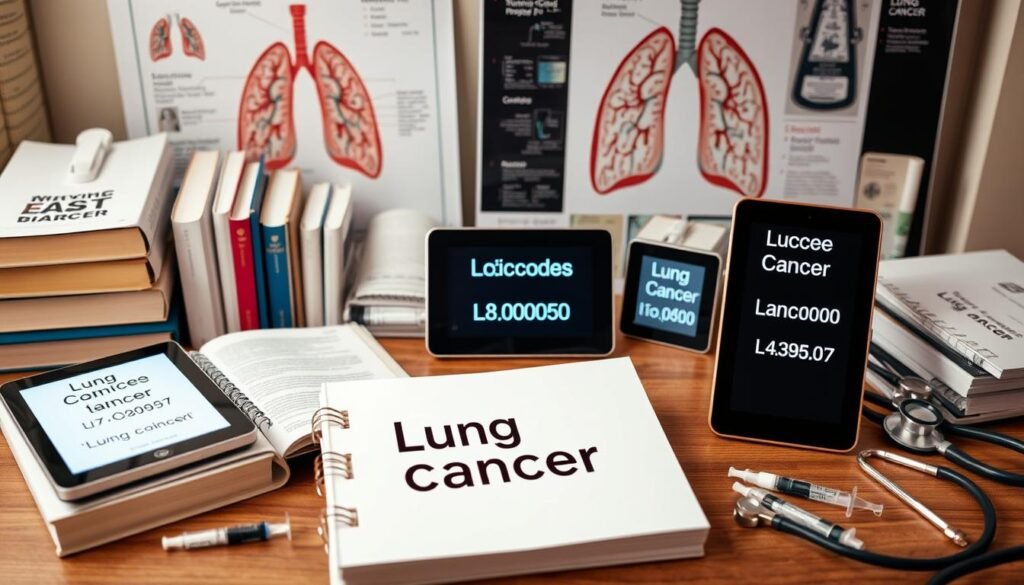Did you know lung cancer causes about 25% of all cancer deaths in the U.S.? This fact shows why we need accurate cancer diagnosis coding, especially for lung cancer. The right dx code affects treatment plans and patient outcomes.
The lung cancer ICD-10 code is key for doctors and patients. It helps them understand the diagnosis and treatment better. It’s vital in the fight against lung cancer.
Coding each case correctly helps with research and billing. As coding changes, staying updated is key for those in cancer care. For more on lung cancer codes, check this detailed guide.
Key Takeaways
- Lung cancer is a leading cause of cancer deaths, making accurate diagnosis coding essential.
- The lung cancer ICD-10 code system facilitates effective communication between healthcare providers.
- Understanding specific dx codes for lung cancer helps in crafting targeted treatment plans.
- Accuracy in coding directly influences insurance claims and patient outcomes.
- Future advancements in coding with ICD-11 promise improved precision and efficiency.
Understanding Lung Cancer and Its Importance in Diagnosis
Lung cancer is the top cause of cancer deaths in North America. It’s expected to affect many globally. Knowing about this disease, its types, and how it progresses is key for treatment. Most lung cancers are carcinomas, starting in the bronchi, bronchioles, or alveoli. Early diagnosis is critical because the disease can progress without notice.
Lung cancer has pre-cancerous conditions, such as in-situ carcinoma. This includes types like squamous cell carcinoma in situ and adenocarcinoma in situ. These conditions can become more severe lung cancers, making early detection crucial for better outcomes. Squamous dysplasia, another pre-cancerous condition, varies in severity. It may hint at more serious conditions that need further checks.
In the US, adenocarcinoma is the most common lung cancer. Its prognosis varies with the cell patterns seen. Meanwhile, small cell carcinoma makes up about 15-20% of lung cancers. It grows fast and needs different treatments than NSCLC. This shows the importance of precise diagnosis and treatment strategies. It also highlights the need for correct lung cancer ICD codes.
The use of lung cancer ICD codes is essential. These codes help in keeping detailed patient records. This assists doctors in tracking treatments and outcomes. Good documentation is needed, especially when 75% of patients are diagnosed at stage III or IV. At these stages, treatment options become limited.
Early detection and follow-up for lung cancer are crucial. Many patients with solitary pulmonary nodules do not get the follow-up they need. This can delay diagnosis and treatment. Public education and screening, like low-dose CT scans for those at high risk, could improve diagnosis and survival rates.
Understanding lung cancer’s global impact is important, especially for high-risk groups. With increasing lung cancer rates, the future of care relies on precise diagnostics and timely interventions. This is vital for the best outcomes for patients.
What is the ICD-10 Code System?
The ICD-10 code system is key for classifying diseases worldwide. It allows healthcare professionals to document with consistent and clear codes. This leads to better health data accuracy, crucial for effective patient care.
Overview of International Classification of Diseases
The International Classification of Diseases (ICD) has many diagnostic codes. These codes cover different health issues. For example, lung cancer codes range from C30-C39 in the ICD-10 system.
Specific codes, like C34, detail lung issues. This helps doctors capture precise patient details.
How ICD-10 Codes Facilitate Healthcare Communication
ICD-10 codes aid in communication between medical staff, insurance companies, and researchers. Codes such as Z77.22 for environmental tobacco smoke exposure and Z72.0 for tobacco use are examples. They help in both patient care and public health planning.
Coding for nicotine dependence as F17 is crucial. It supports treatment options and studies on lung cancer.
| ICD-10 Code | Description |
|---|---|
| C34 | Malignant neoplasm of bronchus and lung |
| Z77.22 | Exposure to environmental tobacco smoke |
| P96.81 | Exposure to tobacco smoke in the perinatal period |
| Z87.891 | History of tobacco dependence |
| Z57.31 | Occupational exposure to environmental tobacco smoke |
| C46.5 | Kaposi’s sarcoma of the lung |
| C7A.090 | Malignant carcinoid tumor of the bronchus and lung |
Lung Cancer ICD-10 Codes Explained
Lung cancer is a major health concern that needs precise diagnosis for proper treatment. The ICD-10 codes for lung cancer are vital in classifying and logging different lung cancers. They help doctors, patients, and researchers greatly.
Specific Codes for Different Types of Lung Cancer
The main ICD-10-CM code for lung cancer is C34. This includes a variety of specific codes pinpointing the cancer’s exact location in the lung or bronchus. Among these are:
- C34.90: Malignant neoplasm of an unspecified part of the lung
- C34.11: Malignant neoplasm of the upper lobe, right lung
- C34.12: Malignant neoplasm of the upper lobe, left lung
- C34.2: Malignant neoplasm of the bronchus
Using these codes to thoroughly document lung cancer is crucial. It helps in compiling a detailed medical history important for patient care.
Importance of Documenting Cancer Location
Correctly noting the cancer’s location is key for treatment and billing. Knowing where the lung cancer is helps in making specific treatments and checking how well they work. It also makes the insurance process smoother. If the coding is off, it could disrupt the patient’s journey through care.
dx code for lung cancer: Key Codes to Know
Knowing the right dx code for lung cancer is key for healthcare workers. It helps in making sure treatment and records are right. Here, we talk about two main lung cancer codes that are vital for taking care of patients.
C34.90: Malignant Neoplasm of Unspecified Part
The code C34.90 is for cancer in an unknown part of the lung or bronchus. It’s used when doctors don’t yet know exactly where the tumor is. This code lets treatment start even if all details aren’t known, with room to add more specific info later.
C34.11: Malignant Neoplasm of Upper Lobe, Right Lung
C34.11 means the cancer is in the upper part of the right lung. This detail helps doctors treat the cancer more directly. It’s used when the exact place of the cancer is known, helping to better plan the patient’s care.
Using the right codes for lung cancer makes a big difference. It helps doctors talk to each other better, improve how well patients get better, and makes billing smoother.
| ICD Code | Description |
|---|---|
| C34.90 | Malignant Neoplasm of Unspecified Part |
| C34.11 | Malignant Neoplasm of Upper Lobe, Right Lung |
Implementing Lung Cancer Diagnostic Coding
Getting lung cancer diagnostic coding right is key in treating it well. Doctors need accurate data to make the best treatment plans. This helps in giving each patient the care they deserve. Good coding also makes doctors work together better.
Accurate Documenting for Treatment Plans
Choosing the right lung cancer code is vital for treatment. Each code tells doctors important things about the patient’s health. This helps them create care plans that are just right for each patient. Good coding leads to better health outcomes.
Role in Insurance and Billing Processes
Good coding is a must for insurance and billing tasks. It helps healthcare providers get paid on time by insurance companies. This way, doctors can focus on helping patients get better without worrying about money.
| Aspect | Details |
|---|---|
| Documenting ICD-10 Codes | Essential for tailoring treatment plans |
| Impact on Providers | Facilitates efficient reimbursement |
| Compliance Requirements | Requires adherence to regulations |
| Patient Care Continuity | Ensures consistent management across services |
Doing lung cancer coding right makes healthcare better for everyone. It makes the system work smoothly. This way, both patients and doctors win.
The Role of Lung Cancer Codes in Research
Lung cancer codes help us better understand how treatments work and the disease’s reach. They offer key insights into public health by using the ICD-10 coding system. Researchers look at coded data to explore treatment results for lung cancer patients.
Case Studies on Treatment Outcomes
Many case studies show how lung cancer codes impact treatment plans. They provide vital stats on malignant tumors by location. This helps in crafting treatments that work best, improving how patients recover.
Public Health Tracking and Disease Patterns
Using lung cancer codes helps track disease trends, which is key for healthcare providers. It lets them see how common different lung cancers are. Accurate codes reveal care networks, treatment success, and new health strategies. Working together, healthcare workers and coders record lung cancer cases. This is crucial for health projects that meet patients’ needs well. For more on this topic, read this research on lung cancer.

Challenges in Lung Cancer Diagnostic Terminology
Lung cancer terminology is crucial for those in healthcare. It deeply affects treatment choices and how well patients do. Because so many are found with late-stage cancer, being clear in coding is key. This clarity helps prevent common coding errors. Such mistakes could cause wrong diagnoses or care that doesn’t fit the need.
Common Coding Errors and Misdiagnosis
Errors in coding are a big issue in lung cancer misdiagnosis. Healthcare workers often have trouble with the necessary details in a diagnosis. Studies show that many patients need several tests for a correct diagnosis. This long process impacts both their health and the cost of care. For instance, treating advanced lung cancer is costly. Stage IV care may reach up to $21,441 a month, unlike $2,407 for earlier stages. This shows why correct coding and keeping accurate patient records matter. Proper use of lung cancer diagnostic terms can stop such costly errors.
Unpacking the Complexity of Multiple Diagnoses
For healthcare workers, recording several diagnoses is tough due to complex details. Often, symptoms don’t directly suggest lung cancer. This makes coding even harder. Different ways of caring for patients lead to various outcomes. This makes giving the right ICD-10 codes complex. Catching cancer early and keeping records straight helps in giving the right care. Knowing these hurdles shows the need for better training in coding. This training can cut down mistakes and boost care for patients.
Resources for Finding Lung Cancer ICD Codes
Healthcare experts need correct and dependable data when looking for lung cancer ICD codes. There are many online databases and tools to help find codes quickly. These resources help improve coding accuracy, which is essential for patient records and care.
Online Medical Databases and Tools
Many online databases offer detailed coding info for lung cancer. These services let clinicians find the newest ICD codes and guidelines easily. Here are some recommended tools:
- Official ICD-10 Website: Gives the latest updates and in-depth code details.
- AAPC Coder: Easy to use, with a vast database for medical coding.
- CMS Resources: Offers specific guidelines for Medicare coverage and billing.
Staying Updated with Code Changes
Coding standards change often, so it’s crucial for healthcare workers to keep up. Many databases provide alerts on important updates. There are also regular training and webinars for staying skilled. Staying current means better patient care and correct billing.

The Future of Lung Cancer Coding: ICD-11
ICD-11 is coming soon, and it’s a big deal for lung cancer coding. This new system will make cancer classifications more accurate. It’s vital for healthcare workers to know what this change means for their work.
Anticipated Changes and Improvements
With ICD-11, we’ll see big improvements. Documentation will be clearer and more precise. Here are the key updates:
- Coding will be more detailed to identify cancer types, like small cell and non-small cell lung cancers.
- It will be easier to note symptoms and treatments, making records more precise.
- New rules will better handle the special aspects of lung cancer, including risks from smoking and asbestos.
- Coding will also help predict healthcare costs more efficiently, which is important for understanding lung cancer care expenses.
Preparing for the Transition to ICD-11
Getting ready for ICD-11 means taking some important steps. Here’s what healthcare teams need to do:
- There will be in-depth training on the new codes for both coders and medical staff to get everyone up to speed.
- Clear communication will be key to ensure everyone is on the same page about diagnosing lung cancer.
- We’ll need to switch to new coding tools or software that fit with ICD-11.
- Using resources like the official coding guidelines will help stay updated on any changes as the transition happens.
The switch to ICD-11 is a major step forward in lung cancer coding. It means doctors can give better diagnoses and treatment plans. The changes with ICD-11 are set to make a positive difference in patient care and quality.
Effect of Accurate Coding on Patient Care
Accurate coding plays a big role in patient care quality. It involves careful documentation of diagnoses and treatments. This careful work helps doctors talk to each other better.
When coders turn clinical info into codes, it smoothens data exchange. This is essential for managing and coordinating patient care.
Enhancing Healthcare Provider Communication
Right coding links specialists, primary doctors, and other healthcare workers. It makes sure everyone uses the same reliable patient info. This is key to knowing a patient’s past health issues.
It leads to smarter choices and united treatment plans. A study showed lung cancer coding is only right 42.7% of the time. We need to do better to improve how doctors work together in caring for patients.
Impact on Treatment and Patient Outcomes
Good coding affects more than just talking; it changes treatment and patient results. It makes sure the treatment fits the patient’s exact needs. Wrong coding can cause delays and wrong treatments.
For example, not right cancer stage coding messes up survival rates. Following the coding rules from places like the CMS is crucial. Doing coding right means better care and health for patients.

| Type of Cancer | Sensitivity | Specificity | Positive Predictive Value (PPV) |
|---|---|---|---|
| Lung | 42.7% | 94.8% | 88.1% |
| Breast | 51.0% | 98.3% | 65.8% |
| Colorectal | 72.8% | 93.8% | 68.5% |
Conclusion
Understanding lung cancer coding is very important. The ICD-10 system helps classify lung cancer types and locations clearly. For example, it identifies different lung lobes and bronchus cancers. Knowing this helps doctors treat and research lung cancer effectively.
Accurate coding does more than just label the disease. It’s vital for patients with other health issues like COPD or those in chemotherapy. Correct coding leads to customized treatment plans and helps with insurance. Knowing the 5-year survival rate is 20.5% shows why we must keep accurate records. This helps with tracking the disease and researching it.
Groups like Massive Bio are making it easier to join clinical trials. This shows how good lung cancer coding can improve patient care. When healthcare workers understand coding’s value, they help better patient treatments and medical progress.